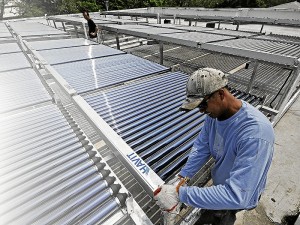Philippine Daily Inquirer 11:47 pm | Friday, May 20th, 2011

A MAINTENANCE crew puts finishing touches on a solar panel installed on the rooftop of St. Augustine building in La Consolacion College Manila, Mendiola. ANDREW TADALAN
That line, of course, is loaded with brightly positive meanings. Though we often view such sunny days as being too hot and sweaty for comfort (especially during summer when the mercury hits the high 30s), to energy conservationists that is a complete blessing.
Inquirer Property has featured these environment-conscious homeowners who have reaped the benefits of the sun’s eternal energy. There’s environment scientist Kelvin Rodolfo and his geriatric-friendly solar-powered 200-square-meter home in Wisconsin (Inquirer Property May 17, 2008 issue), and businessman Ferdie Raquelsantos, who has installed six solar panels and a wind turbine on his roof, generating an equivalent of 1,200 and 900 watts, respectively, of free electricity for his 530-sq-m home in Ayala-Alabang. He now heads Solar and Wind Electric Power Inc. (Inquirer Property Nov. 27, 2010 issue)
Here’s why you should also consider installing solar panels for your own homes:
1 Solar panels reduce your carbon footprint and lower energy bills. Solar energy is harnessed through photovoltaic, or solar, panels that turn light into electricity, explains Kim McKay and Jenny Bonnin, authors of “True Green (100 everyday ways you can contribute to a healthier planet).”
2 Solar power is ideal for structures with high energy demands. Diane Gow McDilda, author of “365 Ways to Live Green,” said many municipalities have installed solar power systems at locations with high energy demands, such as schools and municipal administration buildings. In the Philippines, for instance, the agricultural town of San Manuel installed a solar panel and battery in front of its public cemetery and used that to light its streets and the Doña Carmen Park in the town plaza. The island barangay of Pang-an in Lapu Lapu City has a solar complex at the center comprised of 504 panels generating 90 watts each.
Consider your own household’s power consumption. If it’s big enough (your electricity bill runs above P5,000 a month), then invest in solar panels. A minimum setup of a high-quality solar power system (complete with inverter and electrical wiring) that can generate 1,300 watts of power enough to run a 150 to 200-watt ref, about three 60-watt electric fans, a 150 to 200-watt LCD TV, a 150-watt washing machine and a 600-watt iron, could cost a steep P700,000. A bit pricey, but that could guarantee an instant drop in electric bills, a return on investment after 9 years, and ultimately, up to 40 years of worry-free operations.
Raquelsantos’ setup, for instance, is built to last for that long. He guarantees the system to be 100-percent efficient for 25 years, dropping to 90 percent efficiency on its 40th year.
He cautions would-be users, however, that there are certain power losses even in a properly set up solar panel system. A set that can generate 1,300 watts would, in reality, have a usable energy output of 70 percent (910 watts) only.
The minimum setup for a “grid-tie” system of 1,300 watts (grid-tie means the household is still dependent on a power provider like Meralco) would save homeowners around P3,000 a month in electricity, if they are not enrolled with Meralco’s Time of Use (TOU).
3If you are off-grid (meaning there is no power provider in your area), then a battery system package is what you need. A typical caretaker’s hut in a farm would need two batteries and two 220-watt solar panels, which would cost around P190,000, Raquelsantos estimates.
A smallest package of off-grid battery system—used for storing power that could be used at night especially in farms and provinces—would cost about P20,000. A typical off-grid battery system can power a TV set, electric fan and several lights, and charge a cellphone simultaneously.
4Solar power technology is still in its infancy. And as such, equipment and installation is still more expensive than using traditional fossil fuel options. However, as more private and public power plants are set up and solar cell technology advances, the cost to generate and store solar power is expected to decrease.
5If you choose to use solar panel technology in your home, apply for time-of-use (TOU) with Meralco and slash about 15 percent from your bill, Raquelsantos suggested. Registering for TOU means that when you consume power between 8 a.m. and 9 p.m., you would be charged a higher rate. When you use power between 9 p.m. and 9 a.m. (typically the off-peak hours), you will be charged lower. You can use solar power during the peak hours. At these times, you can do the activities that use up much power, such as run the washing machine, ironing, etc. so you can maximize whatever energy you harvest from your solar power system.
Solar maintenance
6As effective maintenance, clean the panels twice a year to improve their collection of the sun’s rays. Cut away tree branches that may shade the panels.
If your system has batteries, check the level of electrolytes once a month and make sure clamps on the terminals are tight. Other than this, you practically just leave the system as is, as the inverter and charger requires no maintenance.
(Have you discovered a “sunny” solution to your energy needs? We’d like to know. E-mail the author at tsalazar@inquirer.com.ph)